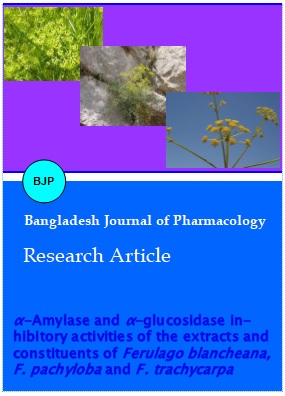α-Amylase and α-glucosidase inhibitory activities of the extracts and constituents of Ferulago blancheana, F. pachyloba and F. trachycarpa roots
DOI:
https://doi.org/10.3329/bjp.v13i1.33668Keywords:
α-Amylase, Ferulago blancheana, Ferulago pachyloba, Ferulago trachycarpa, α-GlucosidaseAbstract
Eleven coumarins named osthole (1), imperatorin (2), bergapten (3), prantschimgin (4), grandivitinol (5), suberosin (6), xanthotoxin (7), felamidin (8), marmesin (9), umbelliferone (10), ulopterol (11), and a sterol mixture consisted of stigmasterol (12), β-sitosterol (13) were isolated from the roots of Ferulago blancheana, F. pachyloba and F. trachycarpa through in vitro bioassay-guided fractionation processes. The extracts and bioactive compounds were evaluated for their α-amylase and α-glucosidase activities. Among the tested compounds, felamidin and suberosin showed significant α-glucosidase inhibitory activity with IC50 values of 0.4 and 0.9 mg/mL, respectively, when compared to the reference standard acarbose (IC50 = 4.9 mg/mL). Grandivitinol (IC50 = 20.0 mg/mL) had the lowest inhibitory effect. On the other hand, none of the tested extracts were found to be active on α-amylase inhibition. This is the first report on isolation, characterization of the bioactive compounds and evaluation the α-amylase and α-glucosidase inhibitory activities of these species.
Video Clip of Methodology:
8 min 26 sec: Click to watch
Downloads
214
227 Read
37

Published
How to Cite
Issue
Section
License
Authors who publish with this journal agree to the following terms:
- Authors retain copyright and grant the journal right of first publication with the work simultaneously licensed under a Creative Commons Attribution License that allows others to share the work with an acknowledgement of the work's authorship and initial publication in this journal.
- Authors are able to enter into separate, additional contractual arrangements for the non-exclusive distribution of the journal's published version of the work (e.g., post it to an institutional repository or publish it in a book), with an acknowledgement of its initial publication in this journal.
- Authors are permitted and encouraged to post their work online (e.g., in institutional repositories or on their website) prior to and during the submission process, as it can lead to productive exchanges, as well as earlier and greater citation of published work (See The Effect of Open Access).
